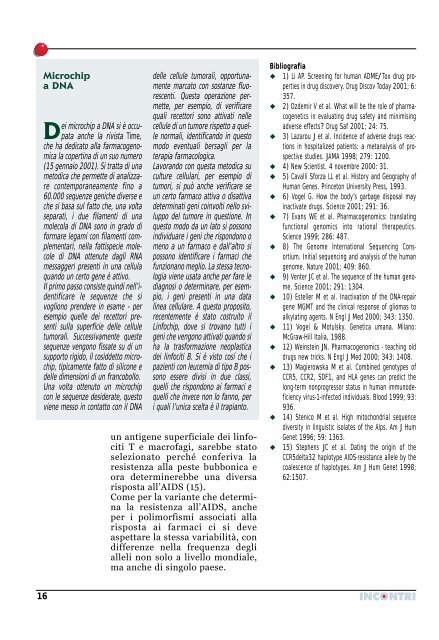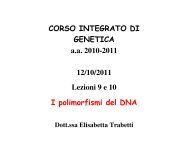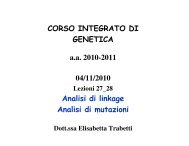Farmaci e genoma - Università degli Studi di Verona
Farmaci e genoma - Università degli Studi di Verona
Farmaci e genoma - Università degli Studi di Verona
You also want an ePaper? Increase the reach of your titles
YUMPU automatically turns print PDFs into web optimized ePapers that Google loves.
Microchip<br />
a DNA<br />
Dei microchip a DNA si è occupata<br />
anche la rivista Time,<br />
che ha de<strong>di</strong>cato alla farmacogenomica<br />
la copertina <strong>di</strong> un suo numero<br />
(15 gennaio 2001). Si tratta <strong>di</strong> una<br />
meto<strong>di</strong>ca che permette <strong>di</strong> analizzare<br />
contemporaneamente fino a<br />
60.000 sequenze geniche <strong>di</strong>verse e<br />
che si basa sul fatto che, una volta<br />
separati, i due filamenti <strong>di</strong> una<br />
molecola <strong>di</strong> DNA sono in grado <strong>di</strong><br />
formare legami con filamenti complementari,<br />
nella fattispecie molecole<br />
<strong>di</strong> DNA ottenute dagli RNA<br />
messaggeri presenti in una cellula<br />
quando un certo gene è attivo.<br />
Il primo passo consiste quin<strong>di</strong> nell’identificare<br />
le sequenze che si<br />
vogliono prendere in esame - per<br />
esempio quelle dei recettori presenti<br />
sulla superficie delle cellule<br />
tumorali. Successivamente queste<br />
sequenze vengono fissate su <strong>di</strong> un<br />
supporto rigido, il cosiddetto microchip,<br />
tipicamente fatto <strong>di</strong> silicone e<br />
delle <strong>di</strong>mensioni <strong>di</strong> un francobollo.<br />
Una volta ottenuto un microchip<br />
con le sequenze desiderate, questo<br />
viene messo in contatto con il DNA<br />
16<br />
delle cellule tumorali, opportunamente<br />
marcato con sostanze fluorescenti.<br />
Questa operazione permette,<br />
per esempio, <strong>di</strong> verificare<br />
quali recettori sono attivati nelle<br />
cellule <strong>di</strong> un tumore rispetto a quelle<br />
normali, identificando in questo<br />
modo eventuali bersagli per la<br />
terapia farmacologica.<br />
Lavorando con questa meto<strong>di</strong>ca su<br />
culture cellulari, per esempio <strong>di</strong><br />
tumori, si può anche verificare se<br />
un certo farmaco attiva o <strong>di</strong>sattiva<br />
determinati geni coinvolti nello sviluppo<br />
del tumore in questione. In<br />
questo modo da un lato si possono<br />
in<strong>di</strong>viduare i geni che rispondono o<br />
meno a un farmaco e dall’altro si<br />
possono identificare i farmaci che<br />
funzionano meglio. La stessa tecnologia<br />
viene usata anche per fare le<br />
<strong>di</strong>agnosi o determinare, per esempio,<br />
i geni presenti in una data<br />
linea cellulare. A questo proposito,<br />
recentemente è stato costruito il<br />
Linfochip, dove si trovano tutti i<br />
geni che vengono attivati quando si<br />
ha la trasformazione neoplastica<br />
dei linfociti B. Si è visto cosí che i<br />
pazienti con leucemia <strong>di</strong> tipo B possono<br />
essere <strong>di</strong>visi in due classi,<br />
quelli che rispondono ai farmaci e<br />
quelli che invece non lo fanno, per<br />
i quali l’unica scelta è il trapianto.<br />
un antigene superficiale dei linfociti<br />
T e macrofagi, sarebbe stato<br />
selezionato perché conferiva la<br />
resistenza alla peste bubbonica e<br />
ora determinerebbe una <strong>di</strong>versa<br />
risposta all’AIDS (15).<br />
Come per la variante che determina<br />
la resistenza all’AIDS, anche<br />
per i polimorfismi associati alla<br />
risposta ai farmaci ci si deve<br />
aspettare la stessa variabilità, con<br />
<strong>di</strong>fferenze nella frequenza <strong>degli</strong><br />
alleli non solo a livello mon<strong>di</strong>ale,<br />
ma anche <strong>di</strong> singolo paese.<br />
Bibliografia<br />
◆ 1) Li AP. Screening for human ADME/Tox drug properties<br />
in drug <strong>di</strong>scovery. Drug Discov Today 2001; 6:<br />
357.<br />
◆ 2) Ozdemir V et al. What will be the role of pharmacogenetics<br />
in evaluating drug safety and minimising<br />
adverse effects? Drug Saf 2001; 24: 75.<br />
◆ 3) Lazarou J et al. Incidence of adverse drugs reactions<br />
in hospitalized patients: a metanalysis of prospective<br />
stu<strong>di</strong>es. JAMA 1998; 279: 1200.<br />
◆ 4) New Scientist. 4 novembre 2000: 31.<br />
◆ 5) Cavalli Sforza LL et al. History and Geography of<br />
Human Genes. Princeton University Press, 1993.<br />
◆ 6) Vogel G. How the body’s garbage <strong>di</strong>sposal may<br />
inactivate drugs. Science 2001; 291: 36.<br />
◆ 7) Evans WE et al. Pharmacogenomics: translating<br />
functional genomics into rational therapeutics.<br />
Science 1999; 286: 487.<br />
◆ 8) The Genome International Sequencing Consortium.<br />
Initial sequencing and analysis of the human<br />
genome. Nature 2001; 409: 860.<br />
◆ 9) Venter JC et al. The sequence of the human genome.<br />
Science 2001; 291: 1304.<br />
◆ 10) Esteller M et al. Inactivation of the DNA-repair<br />
gene MGMT and the clinical response of gliomas to<br />
alkylating agents. N Engl J Med 2000; 343: 1350.<br />
◆ 11) Vogel & Motulsky. Genetica umana. Milano:<br />
McGraw-Hill Italia, 1988.<br />
◆ 12) Weinstein JN. Pharmacogenomics - teaching old<br />
drugs new tricks. N Engl J Med 2000; 343: 1408.<br />
◆ 13) Magierowska M et al. Combined genotypes of<br />
CCR5, CCR2, SDF1, and HLA genes can pre<strong>di</strong>ct the<br />
long-term nonprogressor status in human immunodeficiency<br />
virus-1-infected in<strong>di</strong>viduals. Blood 1999; 93:<br />
936.<br />
◆ 14) Stenico M et al. High mitochondrial sequence<br />
<strong>di</strong>versity in linguistic isolates of the Alps. Am J Hum<br />
Genet 1996; 59: 1363.<br />
◆ 15) Stephens JC et al. Dating the origin of the<br />
CCR5delta32 haplotype AIDS-resistance allele by the<br />
coalescence of haplotypes. Am J Hum Genet 1998;<br />
62:1507.





